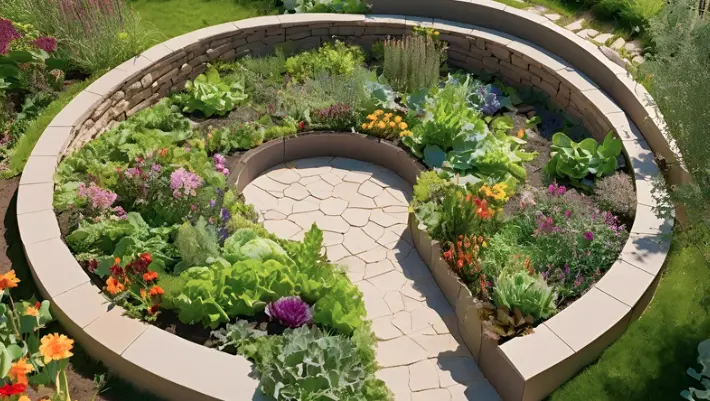In today’s world of gardening, there’s a fascinating and eco-friendly method that’s getting gardeners all around the globe excited and eager to try it out. The keyhole garden, a traditional garden with circular design, its capacity to recycle organic matters and its adaptability to various environments have stirred the gardening community’s excitement.
To build a keyhole garden, begin by selecting a sunny spot with easy access to water. Mark the center where you’ll position the compost basket, then create a circular bed with a convenient and accessible cutout. Fill the bed with a mixture of kitchen scraps and soil, and select plant varieties that thrive in this gardening style, such as choice herbs, lettuce, and tomatoes.
Today, let’s take a closer look at keyhole gardening, exploring how it works and its growing popularity among gardeners. I will guide you through 10 easy steps to build one, ensuring perfect access and availability.
I’ll also share valuable tips on maintaining your keyhole garden and how to steer clear of common challenges associated with this gardening approach. Let’s get started!
What is a Keyhole Garden?
A keyhole garden is a round raised garden bed designed to maximize space and resource efficiency. It is typically circular or semi-circular in shape and features a central composting basket or chamber, which resembles a keyhole when viewed from above.
The original keyhole gardens were often made of dry stacked stone, recycled bricks, pieces of concrete, or really any scavenged material hard enough to hold the soil in and stable enough to support a person’s leaning weight.
Today, they can be constructed from recycled glass bottles, straw bales, wattle (weaving bendy sticks, small branches, twigs, or reeds tightly with each other) , or formalized masonry work. Because of this, keyhole gardening is known for its efficient use of space, water conservation, and the ability to grow a variety of plants in a small area.

Benefits of Keyhole Garden Raised Bed
In the 1990s, the original keyhole raised bed was developed in response to droughts and soil erosion in Lesotho, a compact African nation. Its name, “keyhole,” comes from its resemblance to an antique skeleton-key lock. Keyhole gardening, a form of permaculture (permanent agriculture), is popular among gardeners, and is designed to help those with poor soil grow nutritious produce.
Here are some of its key benefits:
- Water Efficiency: The circular design helps conserve water. As kitchen wastes and water are added to the basket or bin, they release moisture into the surrounding soil, reducing the need for frequent watering.
- Reduced Soil Compaction: Because you can access the entire garden area without stepping on the soil, keyhole gardens minimize soil compaction. This leads to healthier root systems and better plant growth.
- Versatility: Keyhole gardens are versatile and can be adapted to different plant varieties, making them suitable for growing vegetables, herbs, flowers, and even small fruit trees.
- Improved Soil Quality: As time passes, the compost bin at the center of the garden bed adds nutrients to the soil, creating a fertile environment that supports strong plant growth. This can result in larger harvests and healthier crops.
- Weed Suppression: By adding a layer of cardboard or newspaper at the bottom before putting the soil, you can help suppress weed growth, reducing the need for weeding.
Keyhole Garden Design
When you build one for your flower or vegetable garden, you need to consider the following factors:
- Circular Layout: Opt for a semi-circular or circular raised bed layout to maximize space utilization and to avoid it from collapsing.
- Size and Dimensions: Determine the size based on available space and your gardening needs, whether you’re using a kit or opting for a DIY approach. Common diameters range from 6 to 8 feet.
- Location and Sunlight: Choose a location with adequate sunlight for your plants. Keyhole gardens should receive at least 6-8 hours of sunlight daily.
- Accessibility and Pathways: Ensure easy access to the center area of your keyhole garden using pathways or stepping stones for navigation without stepping on the soil.
- Raised Bed vs. In-Ground: Decide whether you want to build a raised keyhole garden bed using materials like bricks or stones or create an in-ground version with a raised center composting mound, meaning instead of a raised circular bed, you dig a circular or semi-circular trench at ground level.
Humble Tip:
You should plan well for pathways and access points to reach the center easily. These paths should be wide enough for you to comfortably reach the composting area and tend to your plants.
Good access ensures that you can easily add kitchen scraps to the compost and maintain your garden without trampling on plants. It also makes the garden more visually appealing.

How to Build a Keyhole Garden Bed
Step 1: Gather Your Materials and Tools
Materials:
- Bricks or stones for the circular bed wall
- Composting basket or chamber
- Soil and compost mix
- Cardboard or newspaper (for weed suppression)
- Small wire mesh (chicken wire or hardware cloth), cut about 4’x 2.5’
- Mulch (optional)
Tools:
- Shovel
- Wheelbarrow
- Gardening gloves
- Tape measure
Step 2: Choose a Location
Choose a suitable location. It is best to choose a level space to minimize the need for flattening or smoothing bumps. Make sure it receives at least 6-8 hours of sunlight each day and is easily accessible for watering and harvesting.
It is advisable to avoid placing your keyhole garden too close to large trees as they can compete for nutrients and water, limit sunlight, and hinder plant growth.
Step 3: Plan the Layout
In planning the layout of your garden, decide on the size and shape of your keyhole bed, including how you will build the wall. Most of the common sizes range from 6 to 8 feet in diameter with a wedge cut out to allow you to reach a basket at the center of the bed.
This central location is the core of its functionality. It’s where organic materials will transform into nutrient-rich compost, nourishing your plants and supporting their growth.
Step 4: Create the Circular Bed Wall
Begin building the circular bed wall, starting from the center point and moving outward. You can use stacked stones, bricks, or concrete blocks to construct the outer wall of the keyhole garden.
Stack materials to create a raised circular structure with an opening for compost access. If you opt to choose chicken wire, secure it with stakes to maintain its position and prevent collapse during soil filling.
Step 5: Install the Composting Basket
The compost basket is a special container placed in the middle of the garden bed. Its purpose is to take leftover vegetable scraps and other organic materials like dried leaves and grass clippings that you put into the basket and turn it into nutrient-rich food for your plants.
To prevent your basket or chamber from becoming excessively wet, it’s important to slope the layers of soil downward and away from the compost cage, allowing water to disperse throughout the plant area.
Step 6: Prepare the Soil
Line the bottom of the keyhole with cardboard or newspaper to suppress weeds. Then, fill the bed with a mixture of good-quality soil and compost pile.
The composting basket in the center will gradually release nutrients from the compost to enrich the surrounding soil, enough that the entire bed benefits from this nourishment.
Step 7: Create Pathways
You need to add or designate pathways or stepping stones within the growing plot or bed to allow easy access to different planting areas without compacting the soil. You have to make sure that the entire bed is within arm’s reach from the compost bin in the center for easy access to the surrounding plants.
Step 8: Plant Your Garden
You can plant your desired vegetables, herbs, and flowers in the prepared soil as this method is versatile and suitable for a variety of plants.
Five excellent plant options are tomatoes, squash, herbs like basil, rosemary, oregano and parsley, lettuce and carrots. They all benefit from the space-efficient design of the keyhole and are great companions to other vegetables as well.
Humble Tip:
You must remember to consider your local climate and growing season when choosing plants for your keyhole garden, as well as any specific preferences you have for your culinary and aesthetic goals.
Step 9: Optional Enhancements
You can add optional enhancements such as a mulch layer around the edges of the bed to retain moisture and suppress weeds. You can also add a fence to protect your plants from animals.
Step 10: Maintain and Water Regularly
Keep the soil consistently moist by using a soaker hose or drip irrigation system and monitor plant health by regularly inspecting your plants for signs of pests, diseases, or nutrient deficiencies, such as yellowing leaves, wilting, or unusual spots.
How To Fill a Keyhole Garden?
Follow these simple steps:
- Layer 1 (Bottom): Start with a layer of cardboard or newspaper at the base of the plant area. This will help suppress the weeds.
- Layer 2 (Soil and Compost): Fill the area with a mixture of good-quality soil and rich compost. You can purchase pre-mixed soil and compost or create your own blend from your kitchen and garden waste.
- Layer 3 (Composting Basket): Make sure that the basket or chamber in the center of the garden is in the right place. As you add kitchen scraps and organic matters to it, it will gradually enrich the surrounding soil.
- Layer 4 (Mulch): You can add a layer of mulch on top of the soil to help retain moisture and gain access to a composting basket to prevent further weed growth. This is optional.
Common Problems of Keyhole Raised Beds
Smell Issues
Smell or odor issues can arise from excessive moisture or improper composting in the central basket. To address this, make sure that your composting materials are balanced (not too wet) and cover them with a lid or dry materials like leaves or straw.
You can also place three to five inches of rocks or large gravel at the bottom of the compost cage to facilitate aeration from the bottom.
Prevent Nutrient Deficiencies
Nutrient deficiencies can stunt the growth of your plants. To prevent this from happening, regularly enrich your keyhole garden’s soil with compostables.
This provides essential nutrients to your plants such as nitrogen, phosphorus, potassium, calcium, and magnesium. Consider using balanced organic fertilizers if necessary and follow recommended application rates.
Drainage problems
Poor drainage can lead to root rot and other issues. To fix this, add gravel or sand at the bottom of the bed before putting in soil to help organic matter decompose. Don’t overwater, and avoid low, soggy spots for your green space.
Managing Weeds
Weeds compete with plants for nutrients and space. To manage them, mulch the soil surface and hand-pull weeds when they appear. Avoid chemical herbicides for an organic and sustainable keyhole garden.
Protection From Pests And Critters
To safeguard your plant area from pests like caterpillars, aphids, rodents, and whiteflies, use barriers like fences or row covers. Attract helpful insects such as bees and employ organic pest control methods like neem oil to maintain a healthy ecosystem.
To deter rodents and minimize attraction to pests:
- Use a secure composting basket.
- Avoid adding meat or dairy to the compost.
- Keep the garden area clean, free of food scraps.
- Monitor for pest signs and use traps or natural repellents as needed.
Conclusion
Keyhole gardens demonstrate sustainability, accessibility, and efficiency in gardening. In this article, we’ve unveiled their secrets: turning recycled materials into fertile soil, their space-saving design, and easy accessibility for all, regardless of physical limitations.
As you contemplate on building your own keyhole garden, remember the core principles: recycling, composting, efficient space use, and nurturing a thriving, accessible plant area. These principles not only benefit your plants but also contribute to a greener, more sustainable world.
So, let the image of your flourishing keyhole garden bed, brimming with vibrant vegetables, fragrant herbs, and colorful flowers, be etched in your mind. As you embark on this adventure called a keyhole garden, you’re not just cultivating plants; you’re sowing the seeds of sustainability, one circular bed at a time.
Frequently Asked Questions
How to Build a Cheap Keyhole Garden?
Create a simple composting basket using chicken wire or recycled materials and instead of using costly stepping stones or pavers, use free or low-cost materials like cardboard covered with mulch to create pathways within the garden.
Do keyhole gardens really work?
Yes, keyhole gardens are effective and have been used successfully by gardeners around the world. The design of keyhole gardens, with a central composting basket and a circular layout, promotes efficient use of space, water conservation, and improved soil quality.
This space-efficient raised bed method of gardening is frequently employed in regions where the soil is not ideal for vegetable cultivation.
What grows best in a keyhole garden?
Keyhole gardens are versatile and can support a variety of plants. Certain vegetables, such as tomatoes, peppers, lettuce, spinach, and carrots, grow well in this environment.
Do keyhole gardens attract rats?
Like any kitchen gardens with organic matter, it can potentially attract pests, including rats, if proper precautions are not taken.
Reference:
- https://www.homedit.com/keyhole-garden/
- https://www.bobvila.com/articles/keyhole-gardening/
- https://learn.eartheasy.com/guides/how-to-build-a-raised-bed-keyhole-garden/
- https://food52.com/blog/26102-how-to-build-a-keyhole-garden-bed
- https://www.gardengatemagazine.com/articles/projects/all/how-to-build-a-keyhole-garden-bed/
Length: 1132
Actual Word Count: 2074
Title Tag: Build a Keyhole Garden Bed: A Complete Guide
Meta Description: Keyhole garden beds are popular among many gardeners because this method uses compost and less water. You can build a keyhole garden using …
Keywords:
- keyhole garden kit
- permaculture keyhole garden
- keyhole garden dimensions
- square keyhole garden
- keyhole garden problems
- diy keyhole garden
- keyhole garden bed with fence
- do keyhole gardens smell
- brick keyhole garden
- keyhole garden bed plans
- do keyhole gardens really work
- what do you fill a keyhole garden with


